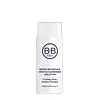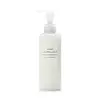What's inside
What's inside
 Key Ingredients
Key Ingredients

 Benefits
Benefits

 Concerns
Concerns

 Ingredients Side-by-side
Ingredients Side-by-side

Water
Skin ConditioningPEG-6 Caprylic/Capric Glycerides
EmulsifyingSodium PCA
HumectantGlycerin
HumectantPEG-40 Hydrogenated Castor Oil
EmulsifyingDipropylene Glycol
HumectantHydroxyacetophenone
AntioxidantCaprylyl Glycol
EmollientCitric Acid
BufferingSodium Hydroxide
BufferingAloe Barbadensis Leaf
MaskingDurio Zibethinus Fruit Extract
Skin ConditioningGarcinia Mangostana Peel Extract
Skin ConditioningLactococcus Ferment Lysate
Skin ConditioningInulin
Skin ConditioningXylitylglucoside
HumectantAnhydroxylitol
HumectantAlpha-Glucan Oligosaccharide
CleansingXylitol
HumectantDipotassium Glycyrrhizate
HumectantSaccharomyces Lysate
Skin Conditioning1,2-Hexanediol
Skin ConditioningXanthan Gum
EmulsifyingDisodium Succinate
MaskingPhenoxyethanol
PreservativeEthylhexylglycerin
Skin ConditioningValine
MaskingThreonine
Glutamic Acid
HumectantGlycine
BufferingButylene Glycol
HumectantGlucose
HumectantSodium Hyaluronate
HumectantChondrus Crispus Extract
Skin ConditioningHydroxypropyltrimonium Hyaluronate
Hydrolyzed Hyaluronic Acid
HumectantSodium Acetylated Hyaluronate
HumectantHyaluronic Acid
HumectantSodium Hyaluronate Crosspolymer
HumectantHydrolyzed Sodium Hyaluronate
Skin ConditioningPotassium Hyaluronate
Skin ConditioningWater, PEG-6 Caprylic/Capric Glycerides, Sodium PCA, Glycerin, PEG-40 Hydrogenated Castor Oil, Dipropylene Glycol, Hydroxyacetophenone, Caprylyl Glycol, Citric Acid, Sodium Hydroxide, Aloe Barbadensis Leaf, Durio Zibethinus Fruit Extract, Garcinia Mangostana Peel Extract, Lactococcus Ferment Lysate, Inulin, Xylitylglucoside, Anhydroxylitol, Alpha-Glucan Oligosaccharide, Xylitol, Dipotassium Glycyrrhizate, Saccharomyces Lysate, 1,2-Hexanediol, Xanthan Gum, Disodium Succinate, Phenoxyethanol, Ethylhexylglycerin, Valine, Threonine, Glutamic Acid, Glycine, Butylene Glycol, Glucose, Sodium Hyaluronate, Chondrus Crispus Extract, Hydroxypropyltrimonium Hyaluronate, Hydrolyzed Hyaluronic Acid, Sodium Acetylated Hyaluronate, Hyaluronic Acid, Sodium Hyaluronate Crosspolymer, Hydrolyzed Sodium Hyaluronate, Potassium Hyaluronate
Water
Skin ConditioningGlycerin
HumectantPEG-7 Glyceryl Cocoate
EmulsifyingHydrogenated Polyisobutene
EmollientCetyl Ethylhexanoate
EmollientPentylene Glycol
Skin ConditioningPropanediol
SolventOlea Europaea Fruit Oil
MaskingIsononyl Isononanoate
EmollientPolyquaternium-51
Skin ConditioningPrunus Armeniaca Juice
MoisturisingPrunus Persica Leaf Extract
EmollientSodium Hyaluronate
HumectantButylene Glycol
HumectantSqualane
EmollientGlyceryl Behenate/Eicosadioate
EmollientPolysorbate 60
EmulsifyingHydroxyethyl Acrylate/Sodium Acryloyldimethyl Taurate Copolymer
Emulsion StabilisingCarbomer
Emulsion StabilisingTocopherol
AntioxidantPotassium Hydroxide
BufferingEthylhexylglycerin
Skin ConditioningPhenoxyethanol
PreservativeCitrus Aurantium Dulcis Peel Oil
MaskingWater, Glycerin, PEG-7 Glyceryl Cocoate, Hydrogenated Polyisobutene, Cetyl Ethylhexanoate, Pentylene Glycol, Propanediol, Olea Europaea Fruit Oil, Isononyl Isononanoate, Polyquaternium-51, Prunus Armeniaca Juice, Prunus Persica Leaf Extract, Sodium Hyaluronate, Butylene Glycol, Squalane, Glyceryl Behenate/Eicosadioate, Polysorbate 60, Hydroxyethyl Acrylate/Sodium Acryloyldimethyl Taurate Copolymer, Carbomer, Tocopherol, Potassium Hydroxide, Ethylhexylglycerin, Phenoxyethanol, Citrus Aurantium Dulcis Peel Oil
 Reviews
Reviews

Ingredients Explained
These ingredients are found in both products.
Ingredients higher up in an ingredient list are typically present in a larger amount.
Butylene Glycol (or BG) is used within cosmetic products for a few different reasons:
Overall, Butylene Glycol is a safe and well-rounded ingredient that works well with other ingredients.
Though this ingredient works well with most skin types, some people with sensitive skin may experience a reaction such as allergic rashes, closed comedones, or itchiness.
Learn more about Butylene GlycolEthylhexylglycerin (we can't pronounce this either) is commonly used as a preservative and skin softener. It is derived from glyceryl.
You might see Ethylhexylglycerin often paired with other preservatives such as phenoxyethanol. Ethylhexylglycerin has been found to increase the effectiveness of these other preservatives.
Glycerin is already naturally found in your skin. It helps moisturize and protect your skin.
A study from 2016 found glycerin to be more effective as a humectant than AHAs and hyaluronic acid.
As a humectant, it helps the skin stay hydrated by pulling moisture to your skin. The low molecular weight of glycerin allows it to pull moisture into the deeper layers of your skin.
Hydrated skin improves your skin barrier; Your skin barrier helps protect against irritants and bacteria.
Glycerin has also been found to have antimicrobial and antiviral properties. Due to these properties, glycerin is often used in wound and burn treatments.
In cosmetics, glycerin is usually derived from plants such as soybean or palm. However, it can also be sourced from animals, such as tallow or animal fat.
This ingredient is organic, colorless, odorless, and non-toxic.
Glycerin is the name for this ingredient in American English. British English uses Glycerol/Glycerine.
Learn more about GlycerinPhenoxyethanol is a preservative that has germicide, antimicrobial, and aromatic properties. Studies show that phenoxyethanol can prevent microbial growth. By itself, it has a scent that is similar to that of a rose.
It's often used in formulations along with Caprylyl Glycol to preserve the shelf life of products.
Sodium Hyaluronate is hyaluronic acid's salt form. It is commonly derived from the sodium salt of hyaluronic acid.
Like hyaluronic acid, it is great at holding water and acts as a humectant. This makes it a great skin hydrating ingredient.
Sodium Hyaluronate is naturally occurring in our bodies and is mostly found in eye fluid and joints.
These are some other common types of Hyaluronic Acid:
Learn more about Sodium HyaluronateWater. It's the most common cosmetic ingredient of all. You'll usually see it at the top of ingredient lists, meaning that it makes up the largest part of the product.
So why is it so popular? Water most often acts as a solvent - this means that it helps dissolve other ingredients into the formulation.
You'll also recognize water as that liquid we all need to stay alive. If you see this, drink a glass of water. Stay hydrated!
Learn more about Water